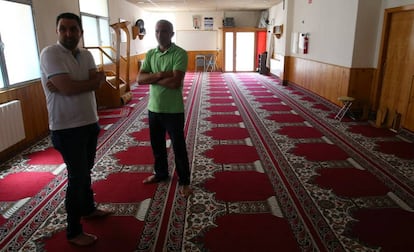How imam who organized Catalonia attacks concealed his radical ideas
Ringleader followed a jihadist manual that permitted adopting the habits and customs of Christians


Abdelbaki Es Satty, the Moroccan imam who headed the terrorist cell that perpetrated the attacks in Catalonia on August 17 and August 18, had been radicalized at least a decade ago. But his training enabled him to lead an outwardly normal life that drew no attention from residents of Ripoll, the small town in the foothills of the Spanish Pyrenees where he lived.
On Saturday evening, hundreds of thousands of people, including King Felipe of Spain, Spanish Prime Minister Mariano Rajoy and regional Catalan premier Carles Puigdemont, marched in Barcelona in a show of unity against the terrorist attack that has claimed 16 lives to date in Barcelona and in the seaside town of Cambrils.
A 51-year-old German woman who was seriously injured in the attack on Barcelona’s La Rambla promenade became the 16th victim of the attacks when she died in hospital on Sunday.
We found nothing relevant and the wiretaps were stopped. Otherwise, we would have arrested him Spanish police officer
Es Satty, who died in an explosion inside a house in Alcanar, some 300 kilometers south of Barcelona, where he and other cell members had been manipulating large amounts of butane gas canisters – presumably to prepare a bomb attack – was trained chiefly by Mohamed Mrabet, a 48-year-old butcher of Moroccan origin who lived in the Catalan town of Vilanova i la Geltrú. Mrabet’s wife, Kdadija Virginia Pood, is a British national who converted to Islam.
Mrabet worked at the Al Furkan mosque by day, and by night he headed an Al Qaeda group that called itself the “Viceless of the West.” Personal documents belonging to Es Satty – which suggest he intended to kill himself in a major attack before his accidental death – turned up inside the home of Mrabet, who spent years sending a long list of volunteers to their death in Syria and Iraq after indoctrinating them at his home. Some of these volunteers achieved their goals: Belgacem Bellil, 31, drove a bomb truck into a group of people in Nasiriyah, Iraq, killing 28 people. Others were caught and sent to Morocco.
Two of the latter, Hassan Mordoude and Ahmed Said Hssisni, were found to have ties to an Al Qaeda group that carried out the Casablanca attacks in 2003. Another suspect was Es Satty. The Spanish police tapped his phone for several months in 2005, but “we found nothing relevant and the wiretaps were stopped. Otherwise, we would have arrested him,” says a senior police officer.
The cell investigated by the police was made up of at least 22 people. After Mrabet was arrested, investigators found a document in his home entitled “Clandestinity in jihad is a legitimate duty.” In 2008 EL PAÍS unveiled the contents of this manual, whose goal is to help jihadists avoid detection.
Lies and disguises are authorized if the goal is to punish the infidels The manual for Salafi jihadism
Es Satty followed these recommendations, making none of the mistakes that might have led to his arrest in Spain. The manual follows the precepts of Takfir Wal-Hijra (“excommunication and exodus”), the most radical and violent strand of Salafi jihadism.
“Secrecy is a key factor in any war. It is a mistake to reject its use in Jihad, because the ruling infidels have recruited thousands of intelligence agents to obtain information from the mujahideen,” reads article 1 of the manual. The second article is even clearer: “The Muslim must imitate the infidels in the way they dress if it benefits Islam. Just like the Jews who used to live in the Arab peninsula in the days of the prophet.”
The instructions went on to encourage lying: “Lies and disguises are authorized if the goal is to punish the infidels.”
Es Satty followed these recommendations, always avoiding beards in his ID photographs and changing his routine. Nobody knew that for a year, he had been meeting the young men who would carry out and prepare the attacks in Catalonia secretly in Ripoll.
Es Satty was their ringleader. Police found a single belt primed with explosives, which they believe was meant for him as the leader of the group. “This man had decided a long time ago to commit a large attack and to go down in history as the perpetrator,” says a police officer and counter-terrorism expert. “His early contacts with the Vilanova cell and his relationship with several volunteers who wanted to join the jihad in Iraq shows that he was moving in those circles for many years. His trip to Vilvoorne [a center of jihadist activity in Belgium] confirms it. It took him a long time to find this group of young men and fulfill his personal dream.”
English version by Susana Urra.
Tu suscripción se está usando en otro dispositivo
¿Quieres añadir otro usuario a tu suscripción?
Si continúas leyendo en este dispositivo, no se podrá leer en el otro.
FlechaTu suscripción se está usando en otro dispositivo y solo puedes acceder a EL PAÍS desde un dispositivo a la vez.
Si quieres compartir tu cuenta, cambia tu suscripción a la modalidad Premium, así podrás añadir otro usuario. Cada uno accederá con su propia cuenta de email, lo que os permitirá personalizar vuestra experiencia en EL PAÍS.
¿Tienes una suscripción de empresa? Accede aquí para contratar más cuentas.
En el caso de no saber quién está usando tu cuenta, te recomendamos cambiar tu contraseña aquí.
Si decides continuar compartiendo tu cuenta, este mensaje se mostrará en tu dispositivo y en el de la otra persona que está usando tu cuenta de forma indefinida, afectando a tu experiencia de lectura. Puedes consultar aquí los términos y condiciones de la suscripción digital.
More information
Archived In
Últimas noticias
The complicated life of Francesca Albanese: A rising figure in Italy but barred from every bank by Trump’s sanctions
How Japan is trying to avert ‘digital defeat’
Pinochet’s victims grapple with José Antonio Kast’s rise in Chile
Reinhard Genzel, Nobel laureate in physics: ‘One-minute videos will never give you the truth’
Most viewed
- Pablo Escobar’s hippos: A serious environmental problem, 40 years on
- Why we lost the habit of sleeping in two segments and how that changed our sense of time
- Trump’s obsession with putting his name on everything is unprecedented in the United States
- The Florida Keys tourist paradise is besieged by immigration agents: ‘We’ve never seen anything like this’
- Charles Dubouloz, mountaineering star, retires at 36 with a farewell tour inspired by Walter Bonatti










































